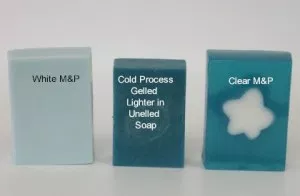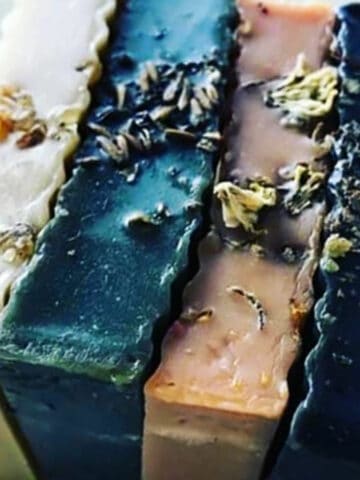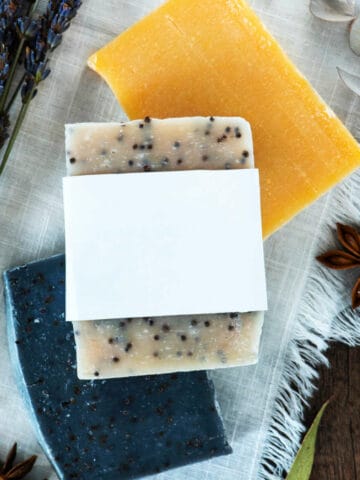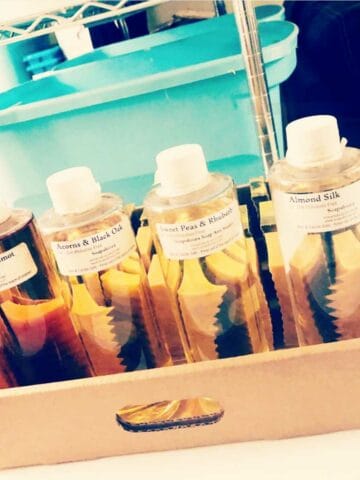
Would anyone here like my method of using DRY Pigments (ultramarines and oxides) and Mica’s with M&P soap? Well, I will share anyway…
Here is the deal… Dyes bleed in M&P soap bases. This is because dyes are water soluble, and “move” through out the hardened soap. Goes back to that old science concept that everything is actually fluid, in a sense. That molecules are just held together. Well, M&P base, when cooled is hard, but it is still considered a ‘liquid’ in the sense that it is a hardened solution.
Dyes (FD&C’s dyes and lakes, etc) are a powder. Most of you can buy them from Bramble Berry in the form of Lab Colors, or the glycerin based dyes at The Chemistry Store, or the liquid dyes at WSP (Whole Sale Supplies Plus). The liquid form in water is also preserved, so you have a long shelf life (so the preservative, as well as the BLEND of dyes used to make the color do get individually included on the soap label for M&P, not for CP, HP).
Pigments are natural occurring mineral substances. The ones we use in soap and cosmetics however are laboratory produced (including Bare Minerals, and yes they are lying about them being “natural”). It is against the US cosmetic safety laws (FD&C Act) to use things we just dig up out of the ground to put into our cosmetics. Black Oxide is easy to find … But it has to be “cosmetic grade” because Black Oxide just dug out of the ground also has Arsenic, Lead, Mercury, etc.. So, it is created in a lab to be safe, or as in the case of Titanium Dioxide, refined.

Pigments are NOT water soluable… HERe is a fun test.. Make a bath bomb using Dyes and a bath bomb using Red Oxide. Take separate baths, and you will see the dye turn the water the color of the dye and nothing on the tub floor or oil ring on the tub. Do the same with the Red Oxide bath bomb, and you will see all the red oxide either settle on the tub floor or stick to the tub ring.
So, You can buy EXPENSIVE glycerine mixed Pigments (Oxides and ultramarines) from soap and cosmetic suppliers (TKB Trading is the BEST www.TKBtrading.com) or you can purchase the ¼ – 1 lb containers of the dry pigments for a fraction of the cost.
Mixing them with glycerine and then coloring your soap alters the soap though. Too much glycerine softens the base, and water will will do the same. Makes for soap that weeps too easy, melts too easy at the craft shows in the summer, and attatracts more moisture from the air. That is because Glycerine is a humicident (attracts moisture, and why natural soap IS so good for us. . it puts a shear sheath on the skin that draws moisture from the air and keeps our skin from drying out or getting the ‘itchies” in the winter).
So, what IS the solution? Well, you need something that will EVAPORATE> So using small pill cups (the little disposable ones that are used for food samples… they are PERFECT)…. Put in about ⅛ of a teaspoon of say Blue Ultramarine. Then add about 1 – 2 teaspoons of simple rubbing alcohol. Then using a pippette dropper, add the amount of color to your melted soap mixture, stirring well.

The alcohol will quickly evaporate from the heat, leaving you no added glycerine or water in your soaps!
Consequently… that same Blue Ultramarine can be used to take the “yellow” out of the clear SFIC bases. I used to distribute this product, and the clear bases tend to run a pale tint of amber to a distinct light yellow. By adding a drop or two of BLue Ultramarine to them, you will have a perfectly water clear base!
Now about the color migration I mentioned earlier…. Dyes will migrate or bleed. Pigments and SOME mica’s will not. Lets talk about Pigments first. Non water soluble as I mentioned already. Make a cookie sheet of soap colored with blue UM. Cut the sheet into stars using a cookie cutter. Melt white soap and do an embed with the blue stars. 1 week later, only the stars will be blue… No movement of color.

Do the same thing with a blue dye… make the sheet, cut it into stars, embed in white soap. 1 week later the white soap will be having blue haze around the area where the blue stars touch the white soap. 1 month later the white is all pale blue. 3 months later, the entire soap is all blue with no distinct blue stars. This is called “Bleeding”.
Mica’s are a subtrate that have various dye’s sprayed on them. Just like pigments we can not use naturally occuring mica in soap and cosmetic. Most, not all, but most dyes will bleed. The Lakes are the category of FD&C that will not bleed. TKB trading gives the ingredient list for each colorant, so you can determine if you mica will bleed or not. Also, as M&P soap makers, you will not have to worry about Dye or Mica “morphing” which is the chemical craziness that occurs when some dye come into contact with Alkali (Lye, sodium hydroxide). Some dyes react due to the very base pH of sodium hydroxide, and you get a Moon Man Puke color instead of what you planned, surprise surprise,
More questions… give me a shout out. I’ve a lot of experience!




Leave a Reply